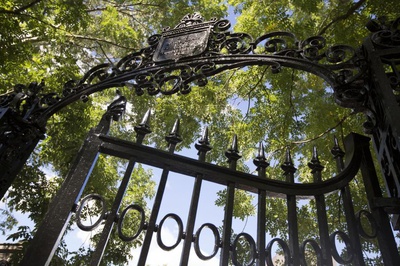
News
Harvard Researchers Develop AI-Driven Framework To Study Social Interactions, A Step Forward for Autism Research

News
Harvard Innovation Labs Announces 25 President’s Innovation Challenge Finalists

News
Graduate Student Council To Vote on Meeting Attendance Policy

News
Pop Hits and Politics: At Yardfest, Students Dance to Bedingfield and a Student Band Condemns Trump

News
Billionaire Investor Gerald Chan Under Scrutiny for Neglect of Historic Harvard Square Theater
The Conspiracy Theory Behind the War on DEI
Amidst the controversy over Diversity, Equity, and Inclusion, the conspiratorial drone of its emboldened critics is louder than ever.
Listen too closely, and you’ll hear distorted narratives that misrepresent the University, students, and history alike, twisting marginalized identities into rhetorical weapons for right-wing agendas.
Nowhere is this clearer than in the myth of “cultural Marxism.”
The Heritage Foundation offers a 45-page report on combating it. Sen. Ted Cruz wrote a book decrying it. GOP lawmakers in Florida have even proposed teaching kindergarten students about the idea.
This conspiracy stemmed from the fringes of the alt-right before migrating to mainstream thought. The theory typically claims that a 20th-century cabal of leftist intellectuals successfully engineered a vast takeover of Western institutions.
For many adherents, the center of the conspiracy is the Frankfurt School, a group of mostly Jewish intellectuals in Germany. As theorists, they critiqued and adapted Marx’s ideas to analyze culture. Critical of both fascism and Soviet-style communism, they tried to understand what enabled the rise of totalitarianism.
Reactionary pundits today distort their work, portraying a set of Jewish academics as masterminds of DEI, feminism, and identity politics to scapegoat them for broader social changes.
In the process, old conspiracies about Jewish people are laundered by new language.
Michael J. Minnicino — who has been described as the importer of the conspiracy theory to the U.S. — repudiated it after a Norwegian neo-Nazi killed 77 people in a terrorist attack and faulted “cultural Marxism” for Muslim immigration to Europe.
Rather than understanding left-wing political critiques as developing in response to social problems, the “cultural Marxism” conspiracy posits an imagined, often implicitly Jewish enemy at play.
For Ted Cruz and the Heritage Foundation, it’s to blame for pro-Palestine protests. For Republicans like Sen. Eric Schmitt, it explains the prevalence of campus diversity, equity, and inclusion efforts.
After all, what else could account for campus organizing, DEI, or the left-wing tilt of universities? It couldn’t be, say, a bloody war waged by an apartheid government, decades of exclusion from the academy, and the curious critical thinking that motivates research.
It must be those neo-Marxists.
Time and time again, Jewish identity becomes instrumentalized to serve ideological battles in ways that have little to do with their lived experience.
Sometimes, they are handed culpability as the corrupting force responsible for leftist politics: See how one New York Post story promoted a dishonest effort to suggest that George Soros, a wealthy Jewish philanthropist, is to blame for pro-Palestine campus protests.
Other times, they are positioned as the endangered victims of those same politics. Just look to the Harvard professors or members of Congress asserting that DEI is to blame for campus antisemitism.
To balance the obvious dissonance, the identity of some students is dissolved: When Jews advocate for Palestine, their Jewishness is sometimes completely, and intentionally, ignored.
With all the rhetorical maneuvering, Jewish students at Harvard and beyond become ideological stand-ins rather than people with complex and differing views. I fear how many of my Zionist and Jewish classmates lend support to these efforts, including at the Republican National Convention.
While these discursive methods may temporarily discredit pro-Palestinian advocates, the conspiratorial thinking — gone unchecked — reinforces the same techniques of paranoia and scapegoating weaponized against all minority groups.
In the end, we are all hurt. The recent Antioch High School shooting suspect — an apparent neo-Nazi — called for violence against Jews, Palestinians, and Black people alike in his manifesto. The alt-right has blended and fused antisemitism, Islamophobia, and racism to form a potent ideology that is killing all manner of marginalized people.
Let’s not add fuel to their fire.
Understanding these conspiracies may suggest why a figure like Rep. Elise Stefanik ’06 finds political opportunity in simultaneously crusading against Harvard for antisemitism while endorsing an admirer of Hitler and echoing the “great replacement” theory. By selectively invoking antisemitism, Stefanik seems to use Jewish students as rhetorical tools, not to combat hatred, but to attack higher education.
If we are serious about addressing antisemitism on campus, we must recognize that this is not a problem of the left or the right. It is a problem of power and paranoia.
The true danger to academic freedom and democracy does not come from DEI, but from those who, in their fervor to dismantle it, are willing to embrace the darkest traditions of suspicion and hatred.
We must not be fooled into helping them.
Zakiriya H. Gladney ’27, a Crimson Editorial editor, is a double concentrator in Statistics and Social Studies in Dunster House.
Want to keep up with breaking news? Subscribe to our email newsletter.
From Our Advertisers

Over 300+ courses at prestigious colleges and universities in the US and UK are at your disposal.

Where you should have gotten your protein since 1998.

Serve as a proctor for Harvard Summer School (HSS) students, either in the Secondary School Program (SSP), General Program (GP), or Pre-College Program.

With an increasingly competitive Law School admissions process, it's important to understand what makes an applicant stand out.

Welcome to your one-stop gifting destination for men and women—it's like your neighborhood holiday shop, but way cooler.

HUSL seeks to create and empower a community of students who are seeking pathways into the Sports Business Industry.

